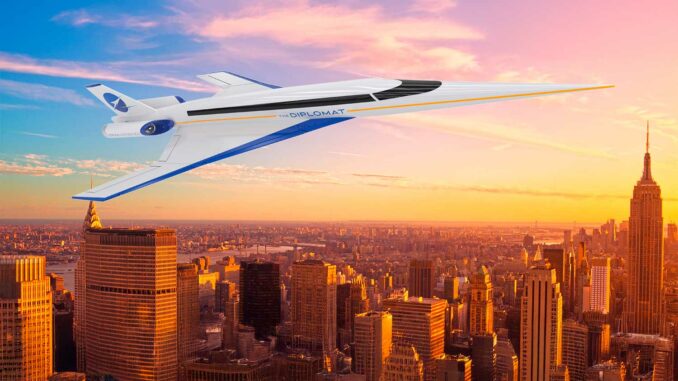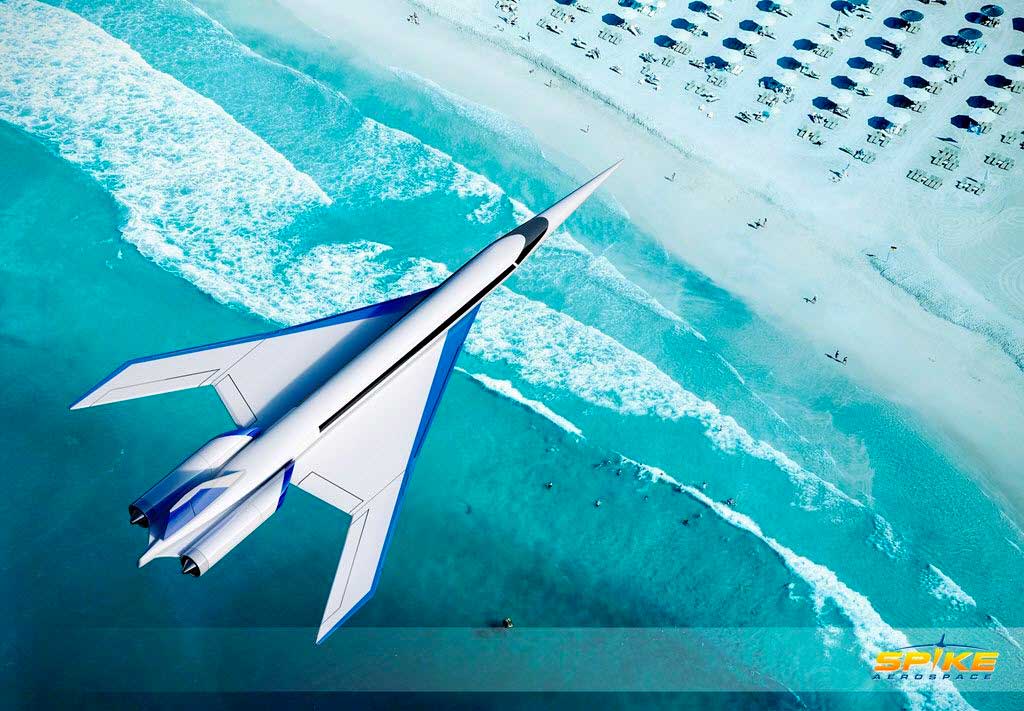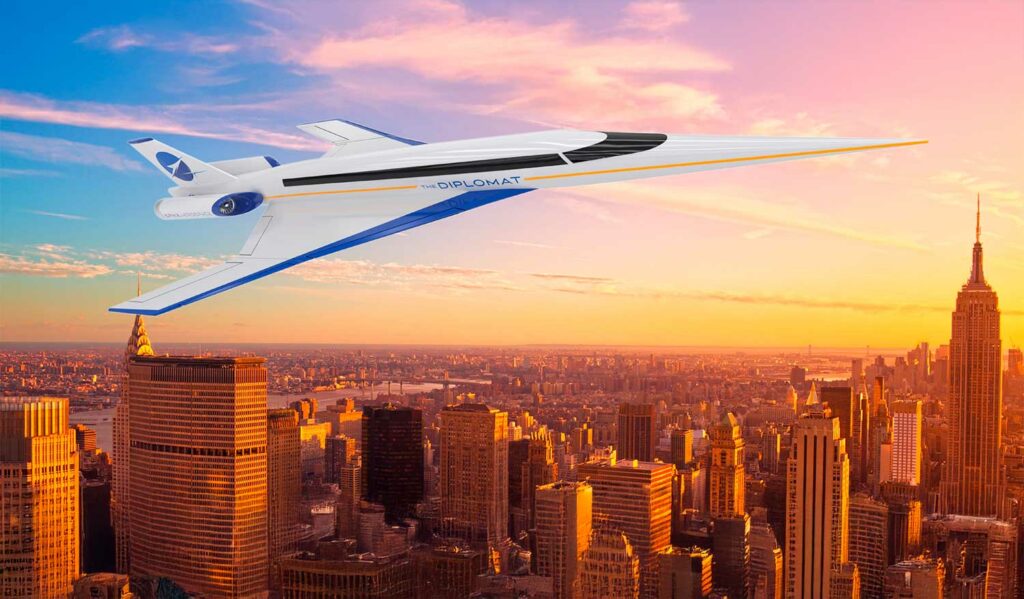
The Spike S-512 Diplomat innovates with low-boom technology, a windowless digital cabin, and efficiency designed for viable civil supersonic flight.
In summary
The Spike S-512 Diplomat is intended to be the technological answer to the historical drawbacks of supersonic flight: noise, fuel consumption, and comfort. Designed to cruise at Mach 1.6, it adopts a low-boom architecture intended to transform the classic sonic boom into a discreet “thump,” one day allowing continental overflights. Its modified delta wing, adjusted using advanced CFD calculations, aims for an optimal compromise between low drag at high speed and subsonic flight performance. In terms of the cabin, Spike eliminates windows in favor of a Multiplex Digital Cabin system: high-definition screens line the walls, displaying panoramic views captured by cameras, which reinforces structural integrity and reduces weight. Finally, the engine and fuselage are designed to take full advantage of sustainable aviation fuels (SAF) and composite materials, seeking unprecedented efficiency for a supersonic aircraft. These innovations, still in the development stage, make the S-512 one of the most credible challengers for a revival of civil supersonic transport.

Overview of the problem: how can supersonic travel be made acceptable?
The sonic boom: a legal and societal obstacle
Since 1973, supersonic flight over land has been banned in the United States due to the noise caused by shock waves—the famous sonic boom. This ban stems from the double “bang” created by the Concorde, with a ground surface pressure often estimated at over 105 PLdB (Perceived Loudness). For a supersonic aircraft to become acceptable again in a civil context, its acoustic signature on the ground must be reduced well below this threshold. Spike is aiming for a level below 75 PLdB, transforming a sharp wave into a diffuse “soft thump”.
To achieve this, the S-512 relies on an aerodynamic design sculpted to redistribute shock waves: generating several mini-humps rather than a single shock. This approach shares principles with NASA’s research on the X-59 QueSST, which aims for an effective ground noise level of around 75 EPNdB. The Phillips S-512 claims to achieve a similar effect through the geometry of its surfaces and control of lateral pressure profiles.
Aerodynamics and modified delta wing
The wing design is a modified delta, with a highly swept inner section and a slimmer outer section. This configuration limits wave drag during supersonic flight while maintaining acceptable behavior in subsonic flight (takeoff, climb, landing).
Spike engineers apply multi-regime CFD models to adjust the relative thickness, laminar transition flows, and wave displacement zones. One breakthrough is the elimination of the horizontal tail in one announced version: lateral/differential control would be sufficient to maintain stability, thereby reducing induced drag and weight. This structural simplification contributes to noise reduction and efficiency.
Every detail—wing/fuselage connections, internal layout, air intakes—is optimized to smooth pressure gradients. The fuselage is streamlined with smooth transitions, promoting wave phasing. The challenge is to avoid a sudden superposition of waves that would generate an audible shock exceeding the permitted noise ceiling.
The windowless digital cabin: more than just an aesthetic gadget
Removal of windows: structural and aerodynamic gains
The removal of windows is a bold move. It eliminates structural weaknesses associated with openings (reinforcements, seals, window jacks) and simplifies the outer skin. This results in a reduction in weight and drag, with a potential gain of a few percent in overall performance. Spike claims that this architecture helps refine the aerodynamic profile and lower the acoustic signature.
Without the constraints of windows, the integrity of the fuselage is reinforced, and the application of thermal loads on the skin is better distributed. This is a key advantage for an aircraft exposed to high temperatures during supersonic flight.
Multiplex Digital Cabin: immersion and control
The interior walls are covered with curved high-definition screens connected to a network of exterior cameras mounted on the fuselage. Passengers can see a real-time panorama of the outside world, or choose alternative content (images, night mode, presentations). These screens are ultra-thin and integrated in such a way as to keep weight to a minimum.
This concept also makes it possible to adjust the brightness, avoid sun glare, and actively manage the cabin atmosphere without blinds. Sound insulation is enhanced by the absence of windows—one of the main sources of noise transmission.
In addition, this system allows for a high degree of comfort customization (display choices, virtual windows, ambiance), while supporting the in-flight silence approach, which is essential in a civil supersonic aircraft.
Internal thermal and acoustic challenges
The Mach 1.6 environment imposes internal thermal constraints. Electronic display panels and cooling systems must withstand high ambient temperatures, thermal gradients, and constant stress. Spike plans to use multi-layer insulation and autonomous cooling circuits for screens and components.
The entire electrical architecture is protected against electromagnetic interference, while the cabin has double shielding to limit engine noise and air friction. The ventilation and pressurization system is designed to absorb structural deformation fluctuations during acceleration.
Energy efficiency and sustainability: the key to success
Optimized engine integration
The choice of engine has not yet been finalized—Spike has announced an architecture designed to accommodate modern, high-efficiency engines. The planned integration aims to minimize drag caused by the nacelles and air intakes, as well as optimize engine/flow adaptation.
The engines are expected to be hybrid or SAF (Sustainable Aviation Fuels) compatible, or even incorporate modulated afterburner technologies to moderate consumption during supersonic flight. The challenge is to provide sufficient thrust at Mach 1.6 without compromising efficiency.
The air intake architecture is crucial: Spike indicates that it will be optimized to maintain stable pressure at the compressors while attenuating shock waves, which reduces overconsumption during speed transitions.
Use of advanced materials and composites
The use of composite materials is essential to lighten the airframe without sacrificing strength. Spike plans to use high-performance fiber-reinforced resin matrix composites combined with metal alloys for areas exposed to high temperatures.
Composites reduce structural mass, allowing for increased payload or lower fuel consumption. However, the materials must withstand rapid thermal cycles and high-speed mechanical stresses. Validating their long-term behavior will be crucial for certification.
Compatibility with sustainable aviation fuels (SAF)
From the design phase onwards, Spike has incorporated SAF compatibility as a requirement. The S-512 will be capable of operating with high-content sustainable fuels, reducing its carbon footprint compared to conventional fossil fuels.
This is a critical asset in the face of environmental regulations: a viable supersonic aircraft must minimize its net emissions. By combining efficiency, lightweight materials, and optimized combustion, Spike aims to achieve an acceptable energy balance for premium commercial use.
Timeline, challenges, and competition
Program relaunch and outlook
Spike relaunched the S-512 Diplomat program in 2025 with a new focus on low-boom performance, aerodynamics, and the cabin. An in-depth study is underway to refine the surfaces, structure, and industrial profitability. The project hopes to gain further credibility in the race for the new generation of supersonic aircraft. (see Aviation Week)
The jet is designed to carry 12 to 18 passengers, with flight times halved on transoceanic routes (e.g., New York–Paris in less than 4 hours). Spike indicates a cruising speed of Mach 1.6 (approximately 1,700 km/h). The target range is around 11,500 km.
However, moving from concept to reality requires certification, test benches, and an assembly line. The number of teams, financing, access to engine technologies, and composite suppliers are all challenges to be overcome.
The contemporary supersonic ecosystem
The S-512 is not alone: other projects such as the NASA X-59 QueSST are testing low-boom technologies (target ~75 EPNdB) to convince regulators to lift bans on overland flights. The S-512 aims to capitalize on these advances. (see X-59)
Private competitors such as Boom Overture and Aerion (before it ceased operations) also aimed to revive supersonic transport. The S-512 stands out for its digital cabin architecture, luxury orientation, and determined low-boom ambitions.

Opportunities, risks, and added value
A premium niche positioning
The S-512 is aimed at companies, heads of state, and private operators seeking maximum speed and discretion. If Spike succeeds in delivering a stable, comfortable, and efficient platform, the market could accept very high prices for this disruptive service.
Dependence on regulations
Even if the design reduces noise, success will depend on regulatory acceptance of supersonic overflight by national authorities and the ICAO. The credibility of acoustic data will be crucial in obtaining exemptions.
Technological and industrial risks
Development involves high risks: composite materials subject to stress, unfinished motorization, cooling, certification, supply chain. If any of these aspects stalls, the project could remain conceptual.
A bold technological leap into the future
The Spike S-512 Diplomat combines a number of innovations (aerodynamic low-boom, digital cockpit, integrated efficiency) to reinvent supersonic flight. Its ambition is to make Mach 1.6 civil flight over continents possible, with comfort, quietness, and sustainability. The challenge remains immense—but it could reshape premium air travel in the coming decade.
War Wings Daily is an independant magazine.